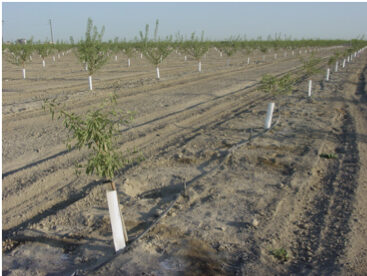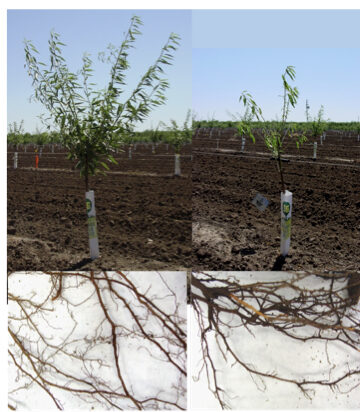
Given the complexity of soils, differences in rootstocks and the economics involved, almond growers have plenty to think about when deciding to replant an orchard. Then, there are the soilborne replant problems.
In a recent interview with West Coast Nut, USDA-Agricultural Research Service Plant Pathologist Greg Browne, who is based in the Department of Plant Pathology at UC Davis, said he likes to break soilborne replant problems into abiotic and biotic components.
On the abiotic side, Browne said that physical and chemical (physicochemical) properties of a soil can make or break the foundation for successful orchard replacement, particularly given that young replanted trees often are more sensitive than mature trees to soil physicochemical challenges – challenges that may have intensified during the previous orchard cycle. These challenges include soil compaction, salt accumulation, pH imbalance and others. Browne added that it is best to assess and address abiotic challenges before replanting and suggested that growers turn to UC recommendations for help in doing so.
Soilborne Pests and Diseases
On the biotic side, Browne and Mohammad Yaghmour, UCCE Farm Advisor in Kern and Kings counties, said several issues can be problematic, including pathogenic nematodes, Phytophthora species, Armillaria mellea (oak root fungus), gophers and a complex referred to as Prunus replant disease (PRD). Depending on what is in a soil and what may be introduced to it from the outside, addressing these biotic challenges may be critical to the success of a replanting operation. Again, Browne and Yaghmour said the best time to prepare for and address them is before replanting.
In looking at plant pathogenic nematodes, Browne noted that many, but definitely not all, almond orchards are infested with them. Browne and Yaghmour said careful soil and root sampling are required to obtain an accurate assessment of nematode risk.
Previous crop history can be used in part to judge risk of diseases caused by Armillaria and Phytophthora, Browne said. Armillaria persists in soil from crop to crop and is aggressive in most almond rootstocks. Phytophthora can also persist indefinitely in soil, but it also can be introduced from infested nursery stock, infested surface irrigation water or contaminated equipment.
Previous problems with Armillaria or Phytophthora are good reasons to think carefully about rootstock selection, Browne noted. Though no almond rootstock is immune to Armillaria, some plum hybrids offer partial resistance. As for Phytophthora, some rootstocks, such as Hansen 536 and other peach-almond hybrids, can be quite susceptible to it when young. Yaghmour noted that many young orchards on Hansen rootstock have suffered from Phytophthora crown rot losses in the south valley.
One of the most common problems almond growers face when replanting is PRD. The disease has a long history in California, dating back to the 1940s.
“From the 40s to the 60s, there were folks at UC Davis who were investigating what they called the peach replant problem,” Browne said. “The same thing they were looking at then, we are looking at now.” It is typified by moderate to severe suppression of tree growth.

Prunus Replant Disease
In contrast to several other replant problems, including nematodes and diseases caused by Armillaria and the Phytophthora species, both of which have wide host ranges and can affect many crops, PRD is relatively specific, Browne said. It affects successive plantings of almonds or other stone fruits that share like rootstocks, but doesn’t affect almonds planted after grape or citrus, for example.
When talking about PRD, Browne emphasizes the word “complex”, pointing out that multiple soil organisms have been associated with the disease over the years that he and others have been researching it. In some soils, he said, specific soil fungi, (e.g. Cylindrocarpon species) and oomycetes (Pythium and Phytopythium species) were associated with affected root systems and tested as pathogenic in his trials. In other PRD cases, however, these organisms did not seem to be involved, whereas certain bacterial taxa exhibited PRD associations.
Browne’s lab, with support from the Almond Board of California (ABC), is still sorting out the complex, he noted. The fact that preplant soil fumigation and other soil disinfestation methods prevent PRD strongly indicates that PRD is mediated in large measures through the soil microbial community, he said. He added that, so far, the most consistent indicators for PRD incidence have been among bacterial taxa.
Browne noted an important distinction between PRD and nematode-driven replant problems. The former affects tree growth most severely during the first few years after orchard replanting, resulting in several years of yield suppression. While the early years of yield loss are never recovered, PRD-affected trees gradually catch up in growth compared to healthy trees, he said. In contrast, although it may take a year or more for nematode populations to “kick in”, they have the potential to hold back orchard performance and yield for the planting’s life span.
Preplant soil fumigation has historically provided the most economical and reliable management approach for PRD and pathogenic nematodes, Browne said. But as regulatory restrictions on soil fumigation intensify, Yaghmour and Browne emphasized that it is important to utilize integrated pest management (IPM), which includes assessing risk and using cultural management and genetic resistance approaches to the extent possible.
Sample Early
In risk assessment, Yaghmour said it is critical for growers to do sampling early. “Growers always need to take nematode samples before planting, even before they remove the previous orchard,” he said. He added that while nematodes aren’t part of the PRD complex, their presence can exacerbate problems with it, particularly given that their populations tend to build over time and the damage that they inflict can be long-term.
Browne and Yaghmour noted that there is no “quick” soil test for PRD (something Browne’s team is working to develop, again with help from the ABC.) Absent that, Browne said the best gauge of PRD risk tends to be past experience.
“Given experience with a certain soil type, soil pH and crop history, and knowledge of the rootstocks involved, one can reasonably gauge what to expect in regard to PRD,” Browne said. Sand and sandy loam soils, for example, tend to have more severity from PRD than finer textured soils. He added that he and Yaghmour are happy to work with growers who are interested in leaving control strips to quantitatively assess fumigation benefits and to help in the development of predictive PRD testing methods.
Preplant fallowing can be used strategically to reduce the need for fumigation to control PRD and nematode replant problems. For example, where the PRD complex is impactful, Browne estimated that the PRD growth suppression it causes can be reduced by roughly 50% for each additional year of fallowing after the removal of an old orchard.
Also, in previous ABC-funded research, Browne found that without preplant fumigation, several peach-almond hybrids suffered less from PRD compared to Nemaguard and other peach rootstocks.
Fumigant Options
When treating with fumigants, Browne said growers need to determine the extent of nematode pressure in an orchard as well as past history with PRD and other factors before selecting a fumigant.
During the phaseout of methyl bromide in the early 2000s, Browne worked with UC Pomology Farm Advisor Brent Holtz and former UC Farm Advisor for Merced County David Doll and others to investigate the efficacy of shank-applied fumigant alternatives. They found that, pound for pound, chloropicrin or combinations of pic with 1,3-dichloropropene (1,3-D, Telone II) were most effective for prevention of PRD. When nematodes also were present, they found that the inclusion of 1,3-D provided important benefits. Using currently allowed rates, the most effective preplant fumigation treatment for PRD and nematode problems tends to involve both 1,3-D and chloropicrin, with the former applied in 50%-strips or broadcast and the latter applied in narrow strips or spots, Browne said.
GPS-controlled spot fumigation, which uses relatively little fumigant, can be a viable option for PRD, Browne added. He noted that he, Yaghmour, Holtz and Phoebe Gordon, UCCE Orchard Systems Advisor for Madera and Merced Counties, are examining non-fumigant methods of managing PRD in a project funded by the ABC.
Anaerobic Soil Disinfestation (ASD)
Among methods the team is studying are anaerobic soil disinfestation (ASD) and strategic fertilization practices.
Browne said he has been working with ASD for six years now as part of his overarching work into developing alternatives to fumigation. In trials to date, optimal ASD treatments have matched or nearly matched preplant soil fumigation for controlling PRD, he said, but ASD was about twice as expensive. The treatment involves incorporating a readily available carbon source into soil, such as rice bran or ground up almond hulls and shells, then covering the soil with a drip irrigation system and overlaying that with a clear tarp for four to six weeks to seal off the soil and raise its temperature as the soil is drip irrigated.
“What happens under the warm, wet conditions is that microbes in the soil, mainly bacteria, go crazy metabolizing the carbon source,” Browne said. “They deplete oxygen in the soil, making it anaerobic within days. Under those conditions, organic acids and volatiles that are lethal to many soilborne pathogens are generated.”
He noted that he and other researchers are working on tweaking the ASD system to make it more palatable for growers to employ. “Our goal is to reduce ASD costs and increase ASD practicality,” he said.
As for rescue treatments, there generally are no great options for either nematodes or PRD, Browne said. “Of course, careful soil water management and fertilization practices can go a long way,” he said.
“And,” he continued, “if a grower can make some judgement calls based on their previous experience with replanted blocks – given certain periods of fallowing, given certain rootstocks – that tends to be a pretty reasonable guide to what they would want to do preplant in terms of managing for PRD and other concerns.”
In the meantime, researchers are continuing to work on the disease complex and hope to further interact with managers about their almond replant problems, especially in regard to assessing the need for fumigation, developing replant diagnostics and testing orchard responses to non-fumigant alternatives.
















